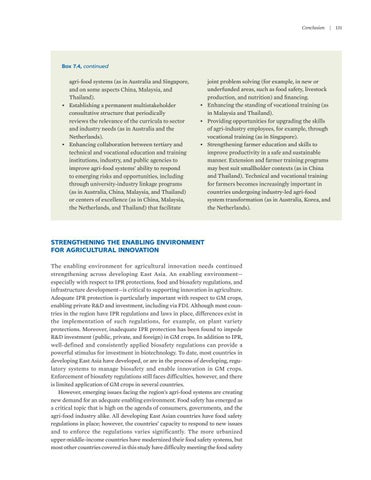Conclusion | 131
Box 7.4, continued
agri-food systems (as in Australia and Singapore, and on some aspects China, Malaysia, and Thailand). • Establishing a permanent multistakeholder consultative structure that periodically reviews the relevance of the curricula to sector and industry needs (as in Australia and the Netherlands). • Enhancing collaboration between tertiary and technical and vocational education and training institutions, industry, and public agencies to improve agri-food systems’ ability to respond to emerging risks and opportunities, including through university-industry linkage programs (as in Australia, China, Malaysia, and Thailand) or centers of excellence (as in China, Malaysia, the Netherlands, and Thailand) that facilitate
joint problem solving (for example, in new or underfunded areas, such as food safety, livestock production, and nutrition) and financing. • Enhancing the standing of vocational training (as in Malaysia and Thailand). • Providing opportunities for upgrading the skills of agri-industry employees, for example, through vocational training (as in Singapore). • Strengthening farmer education and skills to improve productivity in a safe and sustainable manner. Extension and farmer training programs may best suit smallholder contexts (as in China and Thailand). Technical and vocational training for farmers becomes increasingly important in countries undergoing industry-led agri-food system transformation (as in Australia, Korea, and the Netherlands).
STRENGTHENING THE ENABLING ENVIRONMENT FOR AGRICULTURAL INNOVATION The enabling environment for agricultural innovation needs continued strengthening across developing East Asia. An enabling environment— especially with respect to IPR protections, food and biosafety regulations, and infrastructure development—is critical to supporting innovation in agriculture. Adequate IPR protection is particularly important with respect to GM crops, enabling private R&D and investment, including via FDI. Although most countries in the region have IPR regulations and laws in place, differences exist in the implementation of such regulations, for example, on plant variety protections. Moreover, inadequate IPR protection has been found to impede R&D investment (public, private, and foreign) in GM crops. In addition to IPR, well-defined and consistently applied biosafety regulations can provide a powerful stimulus for investment in biotechnology. To date, most countries in developing East Asia have developed, or are in the process of developing, regulatory systems to manage biosafety and enable innovation in GM crops. Enforcement of biosafety regulations still faces difficulties, however, and there is limited application of GM crops in several countries. However, emerging issues facing the region’s agri-food systems are creating new demand for an adequate enabling environment. Food safety has emerged as a critical topic that is high on the agenda of consumers, governments, and the agri-food industry alike. All developing East Asian countries have food safety regulations in place; however, the countries’ capacity to respond to new issues and to enforce the regulations varies significantly. The more urbanized upper-middle-income countries have modernized their food safety systems, but most other countries covered in this study have difficulty meeting the food safety

